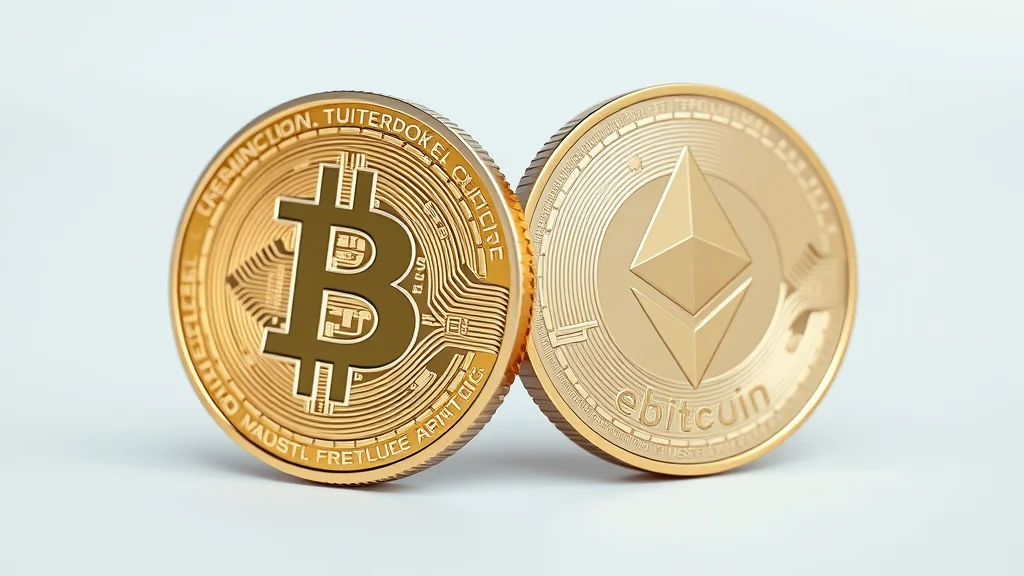Have you ever wondered if Bitcoin and Ethereum are truly rivals in the world of digital assets, or are they simply two sides of the same coin? The answer isn’t as obvious as it first appears. With all the headlines, investment chatter, and debates online, it’s easy to get lost in the noise. In this article, we’ll break down every major difference, explain what sets Bitcoin and Ethereum apart, and give you the practical information you need to make an informed choice about how to use — or invest in — these leading digital currencies.
Unpacking the Bitcoin vs. Ethereum Debate: Why the Distinction Matters
Deciding between Bitcoin vs. Ethereum isn’t just about picking which digital asset you like more. The two biggest names in the cryptocurrency world serve very different purposes and operate on separate foundations. Bitcoin is often called “digital gold” and was the pioneer, created as a new money system free from any central bank’s control. Ethereum, however, takes things a notch further by powering not only its own digital currency (Ether) but also a giant platform for building smart contracts and decentralized apps.
Why does this distinction matter? Imagine choosing between a gold bar and a smartphone — both hold value, but one is for storing wealth, while the other can be programmed to do different things. The point of this debate isn’t just for investors to argue over whose coin will earn more in the next year. The real insight is understanding what you want to do: save, spend, trade, build apps, or all of the above? In a world where access to traditional banks isn’t always guaranteed and privacy is becoming a luxury, figuring out when to use Bitcoin or Ether can make a massive difference. Whether you are looking for reliable savings, want fast transactions, or are curious about the future of finance, this guide will cover all the details.
A Captivating Inquiry: Are Bitcoin and Ethereum Truly Competing or Complementing?
If you dig deeper, you might find that Bitcoin and Ethereum are not always competing—they often complement one another. Both use blockchain technology, but their strengths shine in different places. Bitcoin’s straightforward approach makes it a favorite as a store of value, sometimes called “digital gold.” Ethereum’s flexibility, on the other hand, lets developers build all sorts of apps on its network—from games to financial tools, tapping into DeFi and NFTs. These differences reveal that your choice between Bitcoin vs. Ethereum comes down to your goals — savings, spending, or using crypto for unique new services? Each one fills a special place in the digital finance landscape.

What You'll Learn About Bitcoin vs. Ethereum
- The fundamental differences between Bitcoin and Ethereum
- How bitcoin and ether are used in the real world
- Key concepts like proof of stake, proof of work, and smart contracts
- The impact of transaction speed on blockchain utility
- Expert quotes and perspective on both bitcoin and ethereum
- How to choose between Bitcoin vs. Ethereum for your needs
Bitcoin vs. Ethereum: A Brief Introduction
To truly understand bitcoin vs. ethereum, it’s helpful to look at where it all began. Both were born from the idea of decentralized digital money, but their purposes quickly set them on different paths. Bitcoin came first, launching in January 2009, sending shockwaves through the worlds of banking, finance, and even politics. It introduced the public to blockchain technology and demonstrated how a decentralized digital currency could be possible — without a central bank or government.
Ethereum, launched in 2015, took these ideas and expanded them. While Bitcoin was content to be a peer-to-peer digital cash system, Ethereum’s creator, Vitalik Buterin, wanted a platform that could run smart contracts and support entire decentralized apps (dApps). If Bitcoin is the first digital gold, Ethereum is the Swiss army knife of digital assets. Both platforms have grown their communities and technologies, but they answer different needs. Today, Bitcoin is most famous as a store of value, and Ethereum powers the majority of blockchain development. Knowing these basic differences is vital before diving deeper.
As you explore the unique strengths of each blockchain, it's also worth considering how emerging technologies are shaping their future. For example, the integration of artificial intelligence is beginning to influence which major cryptocurrencies could see the most growth and utility. If you're interested in how AI might impact the leading digital assets, take a look at which crypto majors are poised to benefit from AI advancements and what that could mean for your investment strategy.
Overview of Bitcoin and Ethereum: Origins & Purpose
Bitcoin was created by the mysterious Satoshi Nakamoto and was designed to solve a big problem: How can people exchange money safely, quickly, and fairly, without banks or a central authority? Bitcoin’s secret is its blockchain — a public, open ledger that logs every transaction ever made. Its purpose from the start was simple: transfer value across the world, reliably and with limited supply (a hard cap of 21 million coins).
Ethereum, created by Vitalik Buterin and others, is also built on blockchain technology, but with a twist. Instead of just sending money, Ethereum lets people create their own programs (smart contracts) that run automatically when certain conditions are met. These contracts unlock many possibilities, from lending and borrowing to trading digital collectibles called NFTs. Because of this, Ethereum network hosts hundreds of decentralized apps, making its use cases broader than just sending or receiving digital currency.

Current Roles of Bitcoin and Ether in Digital Finance
Today, bitcoin and ether find themselves at the heart of digital finance, but each has settled into different roles. Bitcoin is trusted for savings and as a “safe haven” during market swings, especially in regions where the local currency is shaky or people are worried about inflation and central bank actions. Its market cap has consistently led the entire cryptocurrency market and is used by millions for stable value storage.
Ether, Ethereum’s currency, is widely used as “fuel” for the Ethereum network. When someone runs a program, interacts with a smart contract, or uses a decentralized app (dApp), they pay fees in ether to make things work smoothly. Beyond being a currency, ether powers decentralized finance (DeFi), where people can lend, borrow, or earn interest — all without traditional banks. As DeFi and NFTs have boomed in the past year, the demand for ether has surged, giving it a unique place in the world of digital assets.
Bitcoin and Ethereum: Technology Foundations Compared
Bitcoin and Ethereum share foundations but have important differences under the hood. Both platforms use blockchain technology to track ownership and transactions securely. However, the Ethereum blockchain is far more flexible — it’s programmable. That means developers can create smart contracts and entire decentralized applications (dApps) on top of Ethereum, while Bitcoin’s programming is intentionally limited, making it simple and secure, but less versatile for development.
This fundamental divergence affects everything from how updates are made (Bitcoin is slow to change; Ethereum evolves fast), to what can be built (digital cash vs. programmable money). Understanding these technological differences is key to understanding why one platform might fit your needs better than the other.
Deciphering Blockchain: How Bitcoin vs. Ethereum Led the Way
At its core, blockchain technology is a public ledger — a digital record that carries every transaction, viewable by anyone but unchangeable after the fact. Both bitcoin and ethereum make use of this, but there’s a difference in how they use blockchain. Bitcoin’s chain is laser-focused on recording transfers of bitcoin. It’s very secure and resistant to change, which is why it’s dubbed “digital gold.”
Ethereum’s blockchain, however, is built for growth and flexibility. It allows for the creation of not only fungible tokens (like ether), but also unique, non-fungible tokens (NFTs), smart contracts, and more. This means anyone in the world can create complex apps on Ethereum — ranging from finance to gaming to digital art. Both blockchains led the way, but Ethereum opened wider doors to what could be done with digital assets.
Smart Contracts: The Ethereum Difference
The single biggest breakthrough Ethereum brought to the table is smart contracts. These are self-executing agreements written into code. For instance, you might set up a smart contract to automatically send funds if your team wins a match, or release a digital artwork to a buyer when payment lands. No need for a lawyer, notary, or central authority. This technology made the Ethereum network a hotbed for decentralized finance (DeFi), NFTs, and countless other decentralized applications.
Because of smart contracts and dapps on Ethereum, the network has attracted an energetic community of developers. It’s become the backbone of the “Web3” movement — a vision of the internet where people control their data and money, not giant tech companies or banks. While Bitcoin delivers robust, reliable payments, Ethereum unlocks a full digital economy, powered by contracts and decentralized applications.

Bitcoin's Simplicity: Digital Cash or Digital Gold?
Unlike Ethereum, Bitcoin likes to keep things simple. It’s designed to be a digital version of cash—or more accurately, “digital gold.” Its strength lies in reliability and security. With a fixed supply (hard cap) of 21 million coins, Bitcoin has become the favorite store of value for many people, especially in regions where inflation is high or financial systems are unstable.
Transactions on the bitcoin network are straightforward and efficient for sending value from A to B, but it doesn’t have the flexibility or programmability of Ethereum. This means fewer features, but also fewer risks and attack surfaces. Bitcoin is trusted globally as a dependable digital asset—a new kind of gold for the internet age.
"Bitcoin and Ethereum serve different purposes, with Bitcoin emphasizing secure value transfer and Ethereum offering a platform for programmable money." — Industry Expert
Consensus Mechanisms: Bitcoin vs. Ethereum Securing Transactions
Both bitcoin and ethereum need to make sure all parties agree on the state of the blockchain at any given time. This process is called achieving consensus. At first, both relied on a technology called proof of work. But Ethereum recently shifted to proof of stake for greater energy efficiency and faster transactions. The difference between these two security models is huge and impacts everything from network energy use to how quickly transactions are confirmed.
Understanding these consensus mechanisms is vital for anyone interested in using, investing, or developing on either platform. It influences transaction fees, security, scalability, and even the environment. Let’s break down what each term means, and why Ethereum made its big switch.
Proof of Work: The Original Security Layer for Bitcoin and Ethereum
Proof of work is the original way that both Bitcoin and Ethereum secured their networks. In this model, miners compete to solve complex math problems; the first to solve one gets to add the next block to the blockchain and earn new coins. It’s highly secure because tampering would require overwhelming the network with computing power, which is nearly impossible for any single attacker.
This system, while secure, is very demanding in terms of electricity. That has led to concerns about its environmental impact, particularly as the popularity and market cap of digital assets have grown. Today, Bitcoin remains proof of work as its core consensus mechanism, while Ethereum has moved forward with a new approach to tackle some of the biggest criticisms around energy consumption.

Proof of Stake: Ethereum’s New Approach for Energy Efficiency
With the transition to proof of stake, Ethereum made a major step towards greater sustainability. Instead of miners running powerful computers, proof of stake selects “validators” based on how much ether they lock up as collateral (or “stake”). These validators are responsible for checking transactions and adding them to the blockchain. The more you stake, the higher your chance to be chosen — but you also risk losing your stake if you cheat.
Moving to proof of stake dramatically reduces energy use and opens the door to much faster scaling. For new users who care about climate change or transaction speed, Ethereum’s upgrade may be a deciding factor. As more platforms shift to this consensus mechanism, proof of work may become an old-school approach, especially as the world seeks greener digital assets.
Bitcoin and Ethereum Transaction Speed & Costs
When considering which to use, transaction speed and fees play a huge role. Bitcoin transactions take time (sometimes up to an hour for full security), with fees that can rise during peak periods. Ethereum’s network, on the other hand, usually processes transactions in seconds or minutes — but its fees (“gas fees”) can also get expensive, especially when the network is busy with lots of smart contracts running at once.
The table below summarizes the core differences. As both networks continue to innovate (with technologies like the Lightning Network for Bitcoin and layer-2 solutions for Ethereum), these numbers may shift over time. Right now, your priorities — speed, cost, or feature set — will help you pick the right digital currency for each job.
| Network | Average Transaction Speed | Typical Fees | Scalability Features |
|---|---|---|---|
| Bitcoin | 10 mins to 1 hour | $1–$5 (high fees during congestion) | Lightning Network, batching |
| Ethereum | Seconds to minutes | $2–$50 (depending on network activity) | Layer 2 (e.g., rollups), sharding (upcoming) |
Real World Applications: Bitcoin vs. Ethereum Use Cases
Bitcoin and Ethereum aren’t just buzzwords on the internet — both have real-world applications that are shaping the way people save, spend, and manage money today. Bitcoin is championed as a digital asset for storing value and making large payments, while Ethereum leads in creating programmable financial products and hosts a whole world of decentralized apps (dApps), decentralized finance (DeFi) protocols, and digital collectibles (NFTs).
From investment portfolios to sending remittances or participating in decentralized lending, the uses for both platforms are evolving rapidly. Let’s see how each technology is used in everyday life, and why users in certain regions or with specific privacy needs might choose one over the other.

Bitcoin Applications: Savings, Payments, and Store of Value
Bitcoin's most famous use is as a reliable savings tool. Many consider it a hedge against inflation—a “digital gold” that resists devaluation from central authority actions. It’s used by millions for cross-border payments, remittances, and even large purchases, thanks to its global reach and falling reliance on traditional intermediaries. In places where banking is difficult, Bitcoin is sometimes a lifeline.
Bitcoin is also used for privacy-centric transactions, where users seek to maintain financial autonomy away from heavy-handed surveillance and central bank controls. Its relatively stable protocol and massive market cap help make it the “money of the internet” for those looking beyond local currencies.
Ethereum Applications: DApps, DeFi, and Beyond
Ethereum powers a vibrant economy of decentralized applications, better known as dApps. These apps let users borrow, lend, earn interest, participate in exchanges, or even play games without any central authority. The Ethereum network is especially famous for its DeFi tools, which let people across the globe access financial products once reserved for banks.
Another area where Ethereum shines is with NFTs (non-fungible tokens) and programmable digital assets. Thanks to its smart contracts, users can create and trade unique items, supporting digital art, music, online identity, and more. If you’re interested in building or using next-generation blockchain technology, Ethereum is usually the first stop.
- Investment
- Sending Remittances
- Privacy-centric transactions
- Smart contract-powered lending
- NFTs and decentralized exchanges
Bitcoin vs. Ethereum: Community, Governance and Development
A major difference between bitcoin and ethereum lies in their open-source communities and approaches to governance. Bitcoin’s developers are known for being conservative, prioritizing stability and security over rapid change. Ethereum’s promoter community is far more willing to experiment and roll out big updates, which can be seen in its recent transition to proof of stake and expanding features for smart contracts and decentralized applications.
The communities around each digital currency impact how quickly each network evolves, adapts to regulations, and responds to security threats or market needs. Understanding these dynamics is valuable for anyone interested in the decentralized technology space.

Open Source Communities and Decentralized Governance
Bitcoin and Ethereum both rely on global networks of open-source developers, but approach governance differently. Bitcoin’s code changes rarely and only after broad community agreement — this stability appeals to those who want assurance against sudden technical shifts. Bitcoin’s “decentralized digital currency” storyline has inspired millions to participate and innovate at the edges.
Ethereum’s governance, meanwhile, is more agile. The Ethereum Foundation and its global contributors frequently propose, test, and roll out upgrades. This has helped Ethereum stay at the cutting edge of blockchain technology, but can also bring growing pains and debates. Both ecosystems are decentralized and open to anyone with new ideas.
Developer Ecosystems: Bitcoin vs. Ethereum Innovators
The developer communities behind bitcoin and ethereum play key roles in each network’s growth. Bitcoin's developer ecosystem focuses on security, network reliability, and slow, careful development. Innovations like the Lightning Network demonstrate how improvements are designed for stability and global accessibility.
Ethereum is often the go-to platform for blockchain startups, thanks to its flexible programming language (Solidity) and vibrant developer community. From decentralized finance to gaming, art, and identity solutions, Ethereum offers fertile ground for experimentation, sparking rapid innovation in digital assets, NFTs, and beyond.
Market Performance, Investment, and Volatility: Bitcoin vs. Ethereum Head-to-Head
If you’re thinking of investing, understanding how bitcoin and ethereum have performed in the cryptocurrency market is essential. Bitcoin usually leads with the largest market cap and serves as a barometer for the entire industry. Ethereum, fast on its heels, has delivered explosive growth, especially as decentralized finance and NFTs have taken off in the past year.
Both assets experience price swings, but with different patterns. Ethereum’s value can be more volatile during times of heavy activity (such as major dApp launches or DeFi protocol releases), while Bitcoin’s price often reflects broader economic sentiments. Here’s a head-to-head comparison:
| Year | Bitcoin Market Cap | Ethereum Market Cap | Notes |
|---|---|---|---|
| 2013 | $1 Billion | N/A | Bitcoin only digital asset in top position |
| 2017 | $230 Billion | $70 Billion | Ethereum’s dApps and ICO boom |
| 2021 | Over $1 Trillion | Over $500 Billion | NFT and DeFi growth, bull market |
| 2024 | Nearly $900 Billion | Over $400 Billion | Ongoing volatility, institutional adoption |
Security, Privacy and Regulation: Navigating Bitcoin vs. Ethereum Risks
No discussion of bitcoin vs. ethereum is complete without mentioning risks. While blockchain technology is generally secure, no system is immune. Bitcoin’s simpler protocol makes it more resistant to bugs and attacks. Ethereum’s power and flexibility, especially with smart contracts, mean there’s more room for errors and exploits if code isn’t perfect.
Privacy on both platforms is high compared to traditional finance, but not complete—both ledgers are public, though addresses are pseudonymous. Regulations are still evolving; some countries restrict or ban crypto, while others adopt it. Always research local laws and risks before investing.
Tip: Use reputable wallets and exchanges, double-check addresses, and keep your private keys secure to boost your crypto safety.
PAA: Is it better to buy Bitcoin or Ethereum?
The Bottom Line: Choosing Bitcoin vs. Ethereum for Investment and Use
Which is better — Bitcoin or Ethereum? There’s no one-size-fits-all answer. If you want digital gold, long-term savings, and stability, Bitcoin may be best. If you’re interested in using digital assets for more than just payments — like accessing decentralized finance, NFTs, and apps — Ethereum is your go-to. For many, having a mix of both is an effective way to balance risk with opportunity. Evaluate your personal goals, risk tolerance, and curiosity about blockchain before jumping in.
PAA: What if I invested $1000 in Bitcoin 10 years ago?
Bitcoin’s Historical Growth vs. Ethereum’s Shorter Timeline
If you had invested $1000 in Bitcoin 10 years ago, you would be looking at a massive return — potentially over a million dollars, depending on exactly when you bought and sold. Bitcoin’s early adopters saw unprecedented gains because it was the first digital currency and benefited from explosive growth and adoption. Ethereum, with a shorter timeline (since 2015), hasn’t had as many years to mature, but it too has delivered significant returns, especially during the recent booms in dApps and DeFi. The past performance of these digital assets is not a guarantee of future results, but it does show their transformative potential.
PAA: Can Ethereum beat Bitcoin?
Ethereum’s Potential Over Bitcoin: Technology and Adoption
Ethereum’s flexible blockchain, smart contracts, and fast-moving developer ecosystem have put it on a trajectory to potentially overtake Bitcoin in some areas, especially as a platform for decentralized technology. While Bitcoin will likely remain #1 for store of value, Ethereum’s edge in smart contract technology and dApps gives it massive utility. The future will depend on market demand, regulation, and continued innovation — but in terms of technology, Ethereum does have the tools to “beat” Bitcoin for certain use cases.
PAA: Why do people use Ethereum instead of Bitcoin?
Smart Contracts and Flexible Use: Ethereum’s Unique Edge
People use Ethereum over Bitcoin when they need more than just a secure way to send money. Ethereum’s smart contracts let anyone create and use decentralized financial services, games, or marketplaces — all without intermediaries. This flexibility and utility has powered Ethereum’s rapid adoption by businesses, developers, and everyday users alike. If you want programmable, flexible, and innovative digital assets, Ethereum is the clear choice.
FAQs on Bitcoin vs. Ethereum
-
Which is safer between Bitcoin vs. Ethereum?
Both are secure, but Bitcoin’s simpler network is less prone to bugs, while Ethereum’s flexibility can introduce more risks if code is not audited. -
Can I use bitcoin on the Ethereum network?
Not directly. Wrapped Bitcoin (WBTC) lets you use bitcoin on Ethereum as a token, but original BTC is native to the Bitcoin blockchain. -
Do both support smart contracts?
Only Ethereum natively supports smart contracts and decentralized applications. Bitcoin is focusing on being a secure payment and store-of-value platform. -
How do fees compare for Bitcoin and Ethereum?
Fees depend on demand. Bitcoin is generally cheaper for basic transfers; Ethereum fees can rise during busy periods, especially when lots of smart contracts run.
Key Takeaways from the Bitcoin vs. Ethereum Comparison
- Main differences between Bitcoin and Ethereum
- When to choose each platform
- Ongoing technological and regulatory changes impacting both
Your Perspective on Bitcoin vs. Ethereum
We'd love to hear what you think about this? Please add your comments below...
Conclusion
Whether you see Bitcoin and Ethereum as rivals or partners, knowing the difference helps you navigate the fast-changing world of digital assets. Make your choice based on your needs—and join the conversation below!
As the digital asset landscape continues to evolve, staying informed about the broader forces shaping crypto is essential for making smart decisions. If you’re curious about the next wave of innovation and want to understand how technologies like artificial intelligence could influence the future of Bitcoin, Ethereum, and other major cryptocurrencies, don’t miss the opportunity to explore deeper insights. Discover how AI integration might redefine the competitive edge of leading crypto assets and unlock new possibilities for investors and developers alike by visiting this in-depth analysis on crypto majors and AI. Expanding your knowledge now could give you a strategic advantage as the worlds of blockchain and AI converge.
Sources
- Ethereum Official Site – https://ethereum.org
- Bitcoin Official Site – https://bitcoin.org
- Coindesk – https://www.coindesk.com
- Investopedia – https://www.investopedia.com
Bitcoin and Ethereum are two of the most prominent cryptocurrencies, each serving distinct purposes within the digital asset landscape. Bitcoin, often referred to as “digital gold,” was designed primarily as a decentralized alternative to traditional currencies, enabling peer-to-peer transactions without the need for intermediaries. Its simplicity and fixed supply of 21 million coins contribute to its appeal as a store of value. (ishares.com)
Ethereum, on the other hand, extends beyond mere transactions by offering a programmable blockchain that supports smart contracts and decentralized applications (dApps). This flexibility has positioned Ethereum as a foundational platform for innovations like decentralized finance (DeFi) and non-fungible tokens (NFTs). (nerdwallet.com)
A key technological difference lies in their consensus mechanisms. Bitcoin employs a proof-of-work (PoW) system, which, while secure, is energy-intensive. Ethereum has transitioned to a proof-of-stake (PoS) model, enhancing energy efficiency and scalability. (nerdwallet.com)
In terms of transaction processing, Bitcoin’s network confirms transactions approximately every 10 minutes, whereas Ethereum’s network processes transactions in about 12 seconds. However, Ethereum’s faster processing times can come with higher transaction fees, especially during periods of high network activity. (ecos.am)
Market performance also differentiates the two. As of October 13, 2025, Bitcoin’s price is $115,680, with a market capitalization of approximately $2.18 trillion, underscoring its dominance as a store of value. Ethereum’s price stands at $4,278.49, with a market cap of around $471.6 billion, reflecting its significant role in powering decentralized applications. (bitdegree.org)
In summary, while both Bitcoin and Ethereum utilize blockchain technology, they cater to different needs: Bitcoin as a robust digital currency and store of value, and Ethereum as a versatile platform for decentralized applications and smart contracts.
 Add Row
Add Row  Add
Add 




Write A Comment